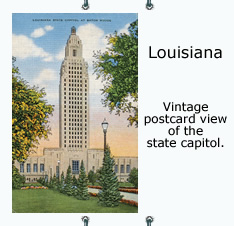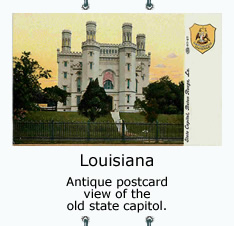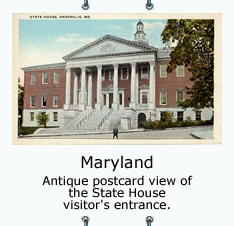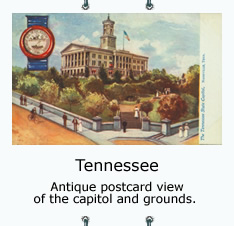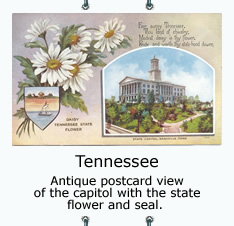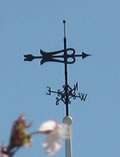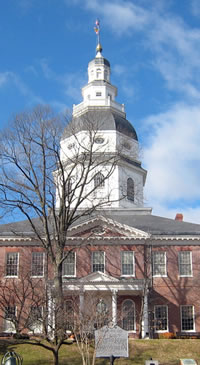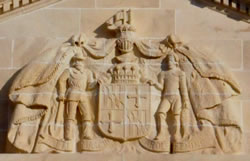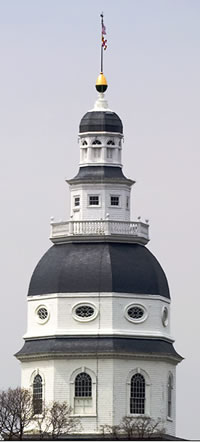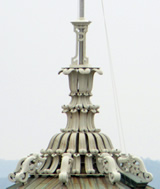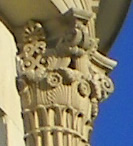What's On Top, Cupola Towers

|
Delaware — Cupola Tower, Staff, Weather Vane |
|
This item is listed in
Visitor Challenge.
|

detail from image at left
|
Cupola Tower
The bottom two sections of the tower are square with red finials at each corner, and the cupola is octagonal with an octagonal, domed roof.
Staff and
Weather Vane
The staff on the cupola roof is topped with a weather vane, which is unusual but not unique. Maryland's State House also has a staff on top, actually a lightning rod, with a weather vane. (See the Maryland section below.) What is unique about Delaware's staff is that it is not used as a flagstaff.
|
|
More on Delaware:
Telling Them Apart, Manhunting, A Poem
Favorites, Just Because
Favorites, Nature
Delaware Postcard & Image Gallery
Capital & Capitol History
Old & New Capitol Timeline
|
| |
statecapitols.tigerleaf.com
What's On Top, Cupola Towers

|
Louisiana — |
Sculptures, Observation Deck, Tiered Cupola,
Flying Buttresses, Beacon |

image courtesy of
Robert Dolton through
Cupolas of Capitalism

Cupola Tower
image courtesy of
Robert Dolton through
Cupolas of Capitalism
|
The Top
For this description, the top of the Louisiana state capitol building starts at the 22nd floor where the tower is decreased in width and cut to an octagon. From here up, there is a large amount of carved and sculpted detailing, and the building is tapered three more times.
Sculptures
The octagonal shape of the building above the first tapering is disguised a bit by the huge sculptures at the smaller four sides, so at first it still looks square. The four winged sculptures represent Law, Science, Philosophy and Art. The top, right image also shows the carved ornamentation between them that runs across the tops of these two tiers.
Observation Deck
Just above the massive sculptures, the second stage of the tapering produces the observation deck. This is most visible in the top, left image.
Tiered Cupola
Starting at the level of the observation deck is a stone, two-tiered cupola or cupola tower of sorts. It is also octagonal.
Flying Buttresses
The transition from the lower to the upper cupola is also disguised, by sculpted flying buttresses also at the smaller sides of the octagonal levels. Above the stone cupolas is another deck with access to the flagstaff.
Beacon
The top-most structure is called a beacon by the Louisiana State offices. It could also be called a cupola or lantern, but since the metal and glass enclosure houses a light, "beacon" seems quite appropriate.
|

Sculpture
detail from image at left

Beacon
image courtesy of
NAMI Louisiana
What is the beacon housing made of? The metal looks like stainless steel in this image.
Is it?
This item is entered in
Visitor Challenge.
|
More on Louisiana:
Telling Them Apart, The Towers
Louisiana Postcard & Image Gallery
Capital & Capitol History
Old & New Capitol Timeline
|
| |
What's On Top, Cupola Towers

|
Maryland — Dome, Cupola Tower, Acorn, Lightning Rod/Flagstaff |
|
Dome
Maryland's octagonal State House dome is made of wood. An outstanding engineering achievement of its time, it was built without metal nails and is still held together with wooden pegs reinforced by iron straps, and is the largest and oldest wooden dome built without nails in the nation. Completed in 1794, the dome is 40 feet across at the base, and 121 feet tall from the base to the copper weather vane on the top of the lightning rod.
The present dome is not the original. The State House, first completed in 1779, included a cupola described in subsequent years as inadequate, unimpressive, and too small for the building. In 1785, a roof replacement project began which included construction of the current dome and cupola tower.
|
Lightning Rod
The original, 28-foot-tall lightning rod is a wrought iron "Franklin" rod. It was constructed and grounded to Benjamin Franklin's specifications. It goes through the center of the acorn, which is there to stabilize the rod. Protecting the original rod is a steel sleeve placed around it during restoration.

image courtesy of
Tom Darden
|
Acorn
Why an acorn? In the late 18th century, acorns were popular decorations symbolizing the strength and potential of an oak tree. Maryland's five-foot-tall acorn was replaced in September 1996 with a copy made of cypress like the original. Its 31 pieces of cypress were all made by different Maryland craftspeople. The assembled acorn was then clad in copper, gilded on top and painted green on the bottom, as in the original plan.
Pediment Sculpture
The visitor's entrance on the west side of the Maryland State House has a pedimented, six-column portico with the pediment sculpture shown at left. The sculpture is a depiction of the seal of Lord Baltimore officially adopted as the seal of the State of Maryland in 1876.
|
More on Maryland:
Telling Them Apart, Manhunting, A Poem
Maryland Postcard & Image Gallery
Capital & Capitol History
Old & New Capitol Timeline
|
| |
Return to Top
|
|
Page Last Updated: May-04-2017
For complete image credits and information sources, see Credits & Sources.
Site Author: Valerie Mockaitis ©2005-2017 Valerie Mockaitis
|
A Special Thank You
to all our Contributors
for their generosity and efforts.
All contributions of content
have been made for no fee,
monetary or otherwise.
|


